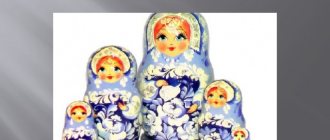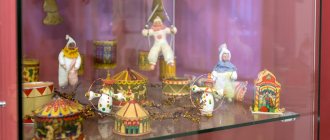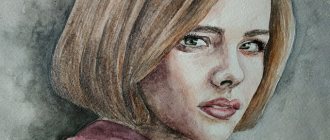“Dymkovo Toy” lesson plan on the world around us (middle group) on the topic
SUMMARY OF NODES ON THE ENVIRONMENT"DYMKOVO TOY"
Goal: Introducing children to folk crafts - the Dymkovo toy.
Tasks:
Educational:
- Introduce the history of the origin of the Dymkovo toy.
- Introduce the variety of Dymkovo toys, the specifics of decor, characteristic elements and color combinations.
Educational:
- Develop speech and memory.
Educational:
- Teach children to see the beauty of the Dymkovo toy, its expressiveness, imagery, and brightness of the pattern.
- Foster a love of folk art.
- To cultivate respect for the work of folk craftsmen.
Priority educational area: “Cognitive development”.
Integration of educational areas: “Cognitive development”, “Socio-communicative development”, “Speech development”, “Aesthetic development”, “Physical development”.
Types of activities: cognitive, communicative, motor, productive.
Methods used: surprise moment, verbal methods (teacher's story, question method, conversation, repetition method), gaming methods and techniques, watching video materials.
Equipment: Dymkovo toys, Parsley, photo and video materials, ball.
Progress of the lesson:
1. Organizational moment.
Educator: Good afternoon, guys! Today the sun looks at us and smiles at us. Let us smile at each other and say all together:
The sun has risen - hurray! (pulls hands up)
It's time for us to get busy! (clap hands)
(Children repeat after the teacher).
2. Main part.
A toy appears in the group.
I am a cheerful toy, and my name is... (Parsley). I'm the most cheerful person in the world, that's why children like me.
I didn’t come to you alone, I brought my friends.
But first tell me, guys, do you have toys? What are they made of?
Children: Our toys are made of plastic, rubber, metal, wood, fabric.
Educator: Guys, look what beautiful friends our Parsley has - toys. Did you recognize them?
Children: This is a horse, a cockerel, a chicken, a fawn.
Educator: The toys invite us to get to know each other better (children go out onto the carpet).
Physical school
We are painted toys, Laughing Vyatkas, Sloboda dandies, Town gossips.
Our hands are like pretzels, our cheeks are like apples. All the people at the fair have known us for a long time.
Parsley addresses the children: Guys, did you like my friends?
What did you like about them?
Children: Beautiful, bright.
Educator: Indeed, these are very beautiful toys. Do they make such toys in the village of Dymkogo?
What is Dymkovo famous for? With his toy. There is no smoky color in it, But there is the love of people.
There is something in it from the rainbow, from drops of dew. There is something of joy in her, thundering like bass.
(V. Feofanov)
Educator: People affectionately and tenderly call this toy “haze.” Where does such an amazing name come from? We will find out now.
From the high bank of the Vyatka River, on which the city of Kirov stands, you can see the settlement of Dymkovo across the river (the picture is shown). In winter, when the stoves are lit, and in summer on cloudy days, when there is fog, the whole settlement is as if in smoke, in a haze. Here, in ancient times, this toy originated. In winter, when people did not have work in the fields, they made whistles from clay. All winter the women of Dymkovo sculpted them for the fair. From a small clay ball with holes, the whistle turned into a duck, a cockerel, or a horse. And now on the trays and counters of the crowded fair they sell cheerful goods. What kind of product is this, let's see? (video “Dymkovo Toys” is shown)
Physical education minute.
Educator: And now Parsley invites everyone to move (children go out onto the carpet):
And now, guys, I call everyone to exercise! Turn left, turn right, bend over, rise up.
Hands up and hands to the side, and jump and jump on the spot! And now let’s run and jump, Well done to all the kids!
Let's slow down, children, and stand still! Like this! And now we will sit down together, We still need to work!
(Children take their seats)
Educator: Guys, tell me, what do all these toys have in common?
Children: All toys have bright colors, everything is on a white background, covered with beautiful patterns.
Educator: What kind of paint do you think the toy is first coated with?
Children: White. The patterns stand out well and beautifully against a white background.
Educator: Can you guess where the masters got the white color from?
Children: They took it from the snow, from winter. The toys were made in winter!!!
Educator: Correct! The white background was taken by the masters from the snow-covered fields, when in winter everything around is white and white. In those places the winter is long and there is a lot of snow. Craftsmen want to make a toy as clean and white as snow. Why were they painted in bright colors?
Children: Because they were made for the holiday, so they painted them with bright colors.
Educator: What colors did the masters use to paint toys?
Children: They used bright colors: red, blue, crimson, yellow, orange, green.
Educator: What patterns do you see on the toys?
Children: On toys there are circles, dots, lines, cells, stripes, curves, waves, squares, rings, ovals.
Educator: Correct. If you look at the pattern of the Dymkovo toy, it is unusually simple (elements of painting are demonstrated).
All toys are not simple, but magically painted.
Snow-white like birch trees, circles, cells, stripes -
It’s a seemingly simple pattern, but I can’t look away.
Educator: What images can be seen in Dymkovo toys?
Children: Horse, cockerel, deer, ram, young lady.
Educator: The most common subjects: nannies with children, water carriers, rams with golden horns, turkeys, roosters, deer and, of course, young people, buffoons, ladies.
Educator: Let's see how a toy is created?
(Children watch the video, the teacher talks at the same time).
A lot of work needs to be put into making the toy look so elegant. She is born three times. The first time she is born is when she is sculpted from red clay. The figures are sculpted in parts, individual parts are assembled and sculpted using liquid red clay as a binding material. Traces of molding are smoothed out to give the product a smooth and neat surface. The toy must be burned to make it durable. The intense heat causes the toy to become hot, and when it cools down, the clay becomes loud and strong. This is how the toy is born a second time. A trial by fire takes place. When is the third time born?
Children: The third time a toy is born is when it is whitened and painted.
Educator: Then they whiten it with chalk diluted with milk and paint it. Sometimes pieces of gold leaf are stuck on top of the pattern, adding even more elegance to the toy. So she is born a third time. Beautiful bright, elegant toys are sold at the fair. Making a toy, from modeling to painting, is a unique and creative process that is never repeated. No, and there cannot be two absolutely identical products. Each toy is unique, unique and inimitable.
Quiz game
Educator: One, two, three - form a circle (children line up in a circle). Let's play a game, I will throw the ball and ask a question, and who caught the ball - answer.
- On what background do craftsmen apply bright patterns? (white)
- What are Dymkovo toys made from? (made of clay)
- What figures are Dymkovo patterns similar to? (geometric)
- What is the name of the village where these amazing toys are made? (Dymkovo)
- What colors are used to decorate Dymkovo toys? (red, blue, yellow, green)
- Where are toys fired? (in the oven)
Physical education minute.
Educator: Now imagine that you and I are masters.
We brought clay from a distant hillock (hands on the belt, turns with a spring) Well, let's get to work, miracle masters! (arms forward, to the sides) Blind, dry - and into the oven! (sculpt with “palms”) And then we’ll paint (fingers with a pinch, draw wavy lines)
The stove glows with heat (the fists clench and unclench). And in the oven there are no rolls, not cheesecakes (they wave their index finger) But in the oven there are toys (hands forward)! (Children sit in their seats)
Educator: Well done! Now listen to the poem.
The fir trees are sleeping by the highway In the gray frost, The trees are sleeping, the river is sleeping, Bound by ice.
The snow is falling softly, blue smoke is curling, smoke is coming out of the chimneys in a column, as if everything is in a haze,
Blue gave, And the village was named Dymkovo. They loved songs and dances there, miracles were born in the village - fairy tales,
Evenings in winter are long, And they sculpted there from clay All the toys are not simple, But they are magically painted:
Snow-white as birch trees, Circles, squares, stripes - A seemingly simple pattern, But I can’t look away.
And the fame of the “haze” began, Having earned the right to this, They talk about it everywhere, We will bow to the amazing miracle more than once.
Educator: Did you like the poem?
What is it about?
3. Summing up.
Educator: Our lesson has come to an end. Parsley says goodbye to you.
Guys, did you like our guest?
What did he introduce you to?
What new have you learned?
Did you like our lesson?
GCD in the middle group Visual activity: Drawing a Dymkovo toy
Topic: “Painting of a bird” (based on the Dymkovo toy), “Goat”.
Author: Tolstopyatova Iraida Anatolyevna, teacher of the MADOU “Sorceress”, Yamalo-Nenets Autonomous Okrug, Labytnangi
Direct educational activity in the middle group Visual activity: “Drawing”.
This lesson is intended for preschool teachers, additional education teachers, parents, children of primary and secondary preschool age.
Topic: “Painting of a bird” (based on the Dymkovo toy), “Goat”. Objectives: To arouse children's interest in fairy-tale images, the desire to decorate the figure with pattern elements (dots, strokes, stripes).
Develop a sense of color, the ability to compare patterns by color, choose the most beautiful ones, using elements of the Dymkovo toy. Use the brush carefully. Foster independence and creativity. Develop imagination, figurative perception, dialogical speech. GCD move.
1. Motivation Nursery rhyme - “Bird Yard” Three turkeys, Three pestles, Three geese - All barefoot Near the house They were bustling around, They were babbling stupidly: -Brr-brr-brr Co-co-co! Ha-ha-ha! Nursery rhyme “Turkey” Turkey-Turkey-Turkey, You look like a chest, The chest is not simple, Red, white, gold. 2. Examination of the Dymkovo toy bird. 3.Teacher's story Today we will go to the workshop of Dymkovo craftsmen. All Dymkovo toys: ladies, buffoons, turkeys, roosters, rams and deer with golden antlers are elegant and festive. Each toy, unique and unique, creates a feeling of fun and celebration. This is a Dymkovo clay toy, named after the village of Dymkovo, where it first appeared. The toys of folk craftsmen were the brightest decoration of the fair with the mischievous and cheerful name “The Whistler”. At this festival, everyone had Dymkovo whistle toys - both children and adults. People believed that they could drive away evil forces by whistling. Modern craftsmen from the city of Kirov continue the folk tradition, and as before, the “haze” shines with all the colors of the rainbow in our homes, bringing joy to children and adults. 4. Demonstration of pattern painting by the teacher. 5. Physical education session Let’s rub our hands hard, stretch each finger. Here we will find a dimple. And we’ll press it a little bit. Now we will stroke the eyebrows and lightly press the temples. We will rub our nose vigorously and press two dots here. We'll do exercises for the ears, and we'll start stroking the neck. And press under the bone. And on our chin we will press this point. 6.Independent activities of pupils.
Children's work 7. Summary. Lesson 2 “Painting the “Goat” (based on the Dymkovo toy) Nursery rhyme “Goat” Our goat He was so smart: He walked on water, He kneaded dough, He heated the stove, He greased cakes with cottage cheese, He sang songs and told fairy tales . Songs are fairy tales, fables, unheard-of things, unheard-of and unheard-of things. Looking at toys (painting)
Independent activity of pupils.
Children's work. The children mastered the painting of the cockerel and the goat and became real masters.
We recommend watching:
Summary of a lesson in the middle group using sand therapy Notes on drawing in the middle group: Multi-colored raindrops Notes on drawing in the middle group on the topic: Spring Notes on drawing in the middle group of kindergarten in accordance with the Federal State Educational Standard
Similar articles:
Folklore entertainment in the middle group
Lesson summary on the topic “Mood” in the middle group
Lesson summary for the middle group on the topic: Transport
Summary of a safety lesson in the middle group
Summary of an etiquette lesson in the middle group






